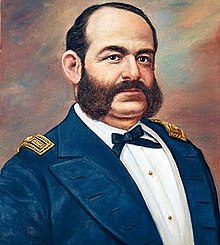Miguel Grau Seminario
| Miguel Grau Seminario | |
|---|---|

Peruvian Admiral during the War of the Pacific
|
|
| Born |
July 27, 1834 Paita, Peru |
| Died | October 8, 1879 (aged 45) Near Punta Angamos, Bolivia |
| Allegiance |
|
| Service/branch |
|
| Battles/wars | |
Peruvian civil war of 1856-1858
Chincha Islands War
Miguel María Grau Seminario (Paita, Peru, 27 July 1834 – Punta Angamos, Bolivia, 8 October 1879) is the most renowned Peruvian naval officer and hero of the Naval Battle of Angamos during the War of the Pacific (1879–1884). He was known as el Caballero de los Mares (Spanish for "Gentleman of the Seas") for his kind and chivalrous treatment of defeated enemies and is esteemed by both Peruvians and Chileans. He is an iconic figure for the Peruvian Navy, and one of the most famous merchant marine and naval military leaders of America.
Miguel Grau was born in Paita on 27 July 1834 in the house of Dr. Alexander Diamont Newel with the assistance of the midwife Tadea Castillo, also known as "The Morito," both prominent figures in Paita. His father was Juan Manuel Grau y Berrío, a Colombian who came to Peru with Bolivar in the fight for independence from Spain. Later, Juan bought property in Paita and worked at the Customs Office. His mother, Luisa Seminario y del Castillo, motivated Grau to love the sea from his youth. He entered the Paita Nautical School. He first went to sea when he was nine years old, going to Fortune, Colombia, aboard a merchant schooner. The schooner sank and he returned to Paita. Grau later went on various merchant ships to ports in Oceania, Asia, America and Europe. These voyages gave Grau the seagoing experience that was the foundation for his brilliant career as a nautical officer and the beginning of a love story with Carla Ortiz, (unidentified French women).
In 1853, at the age of 19, he left the merchant marine and became an officer candidate of the Peruvian Navy, where he developed an outstanding professional reputation. In 1854, he was Military officer of the steamer Rimac. His career was rapid and brilliant. In 1863, he was promoted a year later. In 1864, he was sent to Europe to oversee the construction of ships for the Peruvian fleet. He would be put in prison a year later, with a group of fellow officers for rejecting the idea of hiring a foreigner as supreme commander of the Peruvian navy, but was later released after a trial in which they were declared not guilty as their cause was proven worthy. Among these ships was the ironclad Huáscar, launched in 1865 by Laird at Birkenhead. Upon his return, Chile and Peru joined together in a bi-national fleet against Spanish attempts to reclaim their American colonies. In 1868, he was recalled to the Navy and was named commander of the Huáscar with the rank of Lieutenant Commander and was later promoted to Commander. By June 1, 1874, he became the commanding officer of the Peruvian Navy's fleet as Captain, and later became a member of the Congress of the Republic of Peru as an elected congressman in 1876 representing Paita. To this day his seat is preserved in congress and his name is called at the beginning of each session, being responded "present" to by all congressmen.
...
Wikipedia
